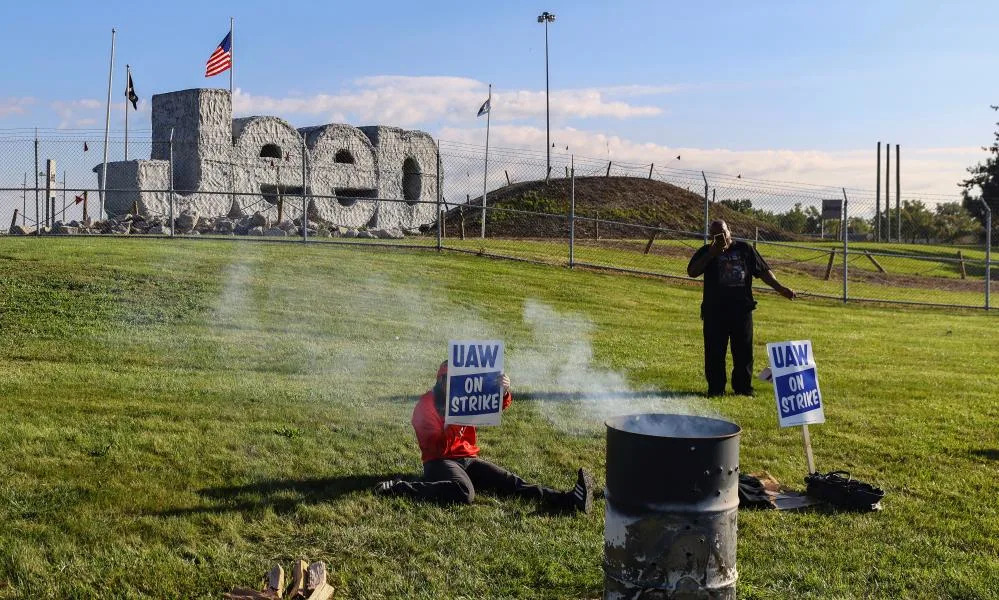Joseph White
Thu, September 14, 2023

FILE PHOTO: United Auto Workers President Shawn Fain greets workers at Ford Motor Michigan Assembly Plant
(Reuters) - He's known to quote the Bible and Nation of Islam civil rights leader Malcolm X. He's a social media fanatic who keeps the pay stubs of his union member grandfather in his wallet. And now, Shawn Fain is representing nearly 150,000 auto workers in one of the biggest labor strikes in decades.
In taking action against all three Detroit carmakers, Fain, the head of the United Auto Workers, has remade the strategy of the union he leads, choosing a bolder, much riskier path than his predecessors after he won office by a narrow margin in a first-ever direct election earlier this year.
The strike started as the clock hit midnight on Friday, and followed Fain's decision to open negotiations with Ford Motor, General Motors and Stellantis simultaneously and eschew public niceties involving choreographed handshakes that famously kicked off previous negotiating efforts.
The strategy is not without risk. A weeks-long strike would hit workers who live paycheck to paycheck, while the Detroit Three automakers have billions in cash to withstand the walkout.
Fain, 54, has made creative use of social media, appearances on network and cable news programs and alliances with high-profile progressive politicians such as U.S. Senator Bernie Sanders, to reframe the UAW's contract bargaining as a battle to re-set the balance of power between workers and global corporations.
He has rebutted automakers' concerns about labor costs by pointing out that they have poured billions into share buybacks to benefit investors. "If they’ve got money for Wall Street they sure as hell have money for the workers making the product," he said. “We fight for the good of the entire working class and the poor."
In lengthy social media talks to UAW members, Fain alternates quoting Bible verses with the use of charts and graphs to dissect wage and benefit offers from the automakers - details his predecessors kept behind closed doors during bargaining crunch time.
Fain, in his unorthodox approach, ran what amounted to a public auction among the companies to push each one to top the other to avoid a costly walkout. Prior UAW presidents picked just one automaker to set a pattern for the other two.
Over and over, Fain has told UAW members at the Detroit Three that they can reverse 20 years of wage and retiree benefit concessions, stop further plant closures and end a seniority-based, tiered compensation system that pays new hires as much as 44% less than veteran workers.
"He's basically showing me who he is and where he comes from every time he presents himself. So, when he shows the plan, I can follow it. I understand that it’s a new way of going about things and I think he’s really shaking them up,” said Darwin Segers, 49, a UAW member who works at the Stellantis Mack Plant in Detroit.
Achieving any one of those goals in one bargaining round would be a significant achievement. UAW-Detroit Three contracts have tended toward incremental change, with worker gains offset by provisions that allowed the companies to drive costs down with automation and process efficiency.
Referring to Biblical scripture, Fain asked union members: "Are you willing to have faith and move that mountain? Nobody’s coming to save us."
Fain, whose grandfather was a UAW member, has escalated his rhetoric - and his stagecraft - since bargaining kicked off in July.
In one of his early Facebook Live videos, he delivered his message wearing a black T-shirt with a quotation from Malcolm X on the back. The Wednesday before contract expiration, he said UAW members must fight for a better contract "by any means necessary" - one of Malcolm X's most quoted phrases.
LONG-TERM TECHNOLOGY THREATS
The crucial test for Fain's strategy comes as the current contracts with the Detroit Three expire. In 2019, the union launched a strike against GM when the company refused to agree to a contract by the deadline. That six-week strike cost GM $3.6 billion and stressed the finances of UAW members.
The union has since beefed up its strike fund to $825 million, but the automakers have much more in cash and weeks of inventory they can run down.
"The UAW needs to be careful not to overplay their hand, as the balance sheets of The Detroit Three are flush with cash and they can probably wait things out longer than the workers can," wrote CFRA Research analyst Garrett Nelson.
Other unions, including Teamsters at delivery giant United Parcel Service and writers and actors in Hollywood, have also been emboldened, and some including UPS have won substantial raises. The actors and writers have been on strike for more than 100 days.
Like the Hollywood unions, the UAW members at the Detroit Three face threats from new technology that a richer contract will not resolve.
Company executives have said the UAW's demands will make them uncompetitive as the shift to EVs offsets the profits delivered by the combustion trucks UAW members build. Ford CEO Jim Farley went even further in a CNBC interview on the day of contract expiration: "You want us to choose bankruptcy over supporting our workers," he said.
Fain dismisses those warnings.
"They pretend the sky will fall if we get our fair share of the quarter of a trillion dollars the Big Three have made over the past decade," Fain said. "It’s the billionaire economy - that's what they are worried about."
(Reporting by Joe White and Ben Klayman in Detroit; additional reporting by Eric Cox in Detroit, Bianca Flowers in Chicago and David Shepardson in Washington; editing by Matthew Lewis and Diane Craft)
'We're not asking to be millionaires': workers strike at US car giants
Car workers have launched a series of strikes after their union failed to reach agreement on a new contract with the three largest US vehicle manufacturers, kicking off the country's most ambitious industrial action in decades.
‘Biggest auto strike in generations’ is here – but why is it happening?
Michael Sainato
Fri, September 15, 2023

Photograph: Jeremy Wadsworth/AP
Industrial action billed as “the biggest auto strike in generations” got under way late on Thursday night for 150,000 US autoworkers, with employees at Ford, Stellantis and General Motors walking off the job at 11.59pm after contract negotiations failed to reach a deal.
Related: The United Auto Workers may soon strike. Every American should support them | Bernie Sanders
It’s the latest in a series of strikes called or threatened by workers in industries including shipping and logistics, TV and movie production and hotel and leisure. Given its scale, the strike could deal a significant blow to the US economy as well as the auto industry.
Why is it happening?
The United Auto Workers union says workers have never been fully compensated for the sacrifices they made after the 2008-09 financial crisis, when they agreed to a raft of cuts to save the industry. The carmakers received huge bailouts and soon returned to record profits.
Workers are pushing for at least a 40% wage increase over four years in a new contract; an end to two-tier wage systems in which new hires are paid significantly less for doing the same work; an increase to benefits for retirees and return of a defined pension instead of a 401k; reinstatement of cost-of-living adjustment raises; a 32-hour working week; job security protections; and protections for workers affected by plant closures.
Who’s leading the charge?
The UAW president, Shawn Fain, was elected to head the union as part of a reform campaign within its ranks, aimed at taking a more aggressive approach towards bargaining after workers had accepted concessions amid bankruptcies during the 2008 economic recession. Workers have yet to regain those concessions, or a share in the $250bn profits the big three automakers have raked in over the past decade.
How did the strike begin?
In late August, the UAW announced members voted about 97% in favor of the strike authorization. The union has never gone on strike at the big three automakers simultaneously.
A minute before midnight on Thursday, after their contracts expired, UAW members walked out at three assembly plants in Michigan, Missouri and Ohio. The union said that about 13,000 workers were affected.
The Detroit Free Press reported that the Stellantis complex in Toledo, Ohio, erupted in cheering and honking of horns as the strike began.
When did the UAW last strike?
Workers at General Motors last went on strike in 2019. It lasted 40 days and cost the carmaker $3.6bn. In 2019, contracts were reached with Fiat-Chrysler, now Stellantis, and Ford without a strike occurring.
What happened to talks?
Talks are going on, “in good faith”, General Motors chief executive Mary Barra said on Friday morning. But management and workers failed to reach an agreement by the midnight deadline when current contracts expired and so the strike began. Fain has previously posted video updates on negotiations in which he has thrown copies of proposals from the automakers in the bin, criticizing the companies’ offers.
In the UAW’s most recent negotiation update, Fain criticized the counteroffers from Ford, Stellantis and GM, saying they keep in place two-tiered wages for workers; rejected their retirement and pension proposals; called wage proposals from Ford and GM “shameful and insulting”; and characterized Stellantis’s offer as “deeply inadequate”. The union has called for significant wage increases that reflect the salary increases of the companies’ CEOs.
“It doesn’t make up for inflation, it doesn’t make up for decades of falling wages and it doesn’t reflect the massive profits we generated for this company,” said Fain.
The automakers have criticized the union’s proposals and claimed they are not “feasible”.
How serious could it get?
In the first instance, the UAW planned “standup” strikes aimed at individual auto plants, with members from three plants walking out overnight after talks failed.
Under this strategy, a strike flares without warning at targeted, individual plants. Then additional locations follow – ramping up the pressure on the companies. UAW says as time goes on, more locals may be called on to join the strike.
“This gives us maximum leverage and maximum flexibility in our fight to win a fair contract at each of the big three automakers.” The option to strike across all facilities is “still on the table”.
What are the costs?
The automotive industry contributes about 3-3.5% of the US gross domestic product (GDP), the broadest measure of the economy.
Vehicle supply – just recovering from pandemic shortages – would be hit hard. A month-long strike at the three automakers could cut output by as many as 500,000 vehicles, according to Sam Fiorani, vice-president of global vehicle forecasting for AutoForecast Solutions.
Ten-day strikes at all three automakers could cost manufacturers, workers, suppliers and dealers more than $5bn, according to economic consulting firm Anderson Economic Group.
Is the White House getting involved?
Biden appeared to support the strikers when he spoke at a press briefing hours after the strike began on Friday. The president said in his White House address: “Record corporate profits … should be shared by record contracts for the UAW.”
He also expressed regret that the strike had not been averted but urged both parties to return to the negotiating table. “No one wants a strike but I respect workers’ rights to use their options under the collective bargaining system and understand their frustrations,” Biden said.
“I do appreciate that the parties have been working around the clock. It is my hope that the parties can return to the negotiating table to forge a win-win agreement.”
His comments came after business groups had been pushing the White House to intervene to avert a strike. Hours after the strike began, the president also reportedly said he would send aides to Detroit to mediate.
No comments:
Post a Comment